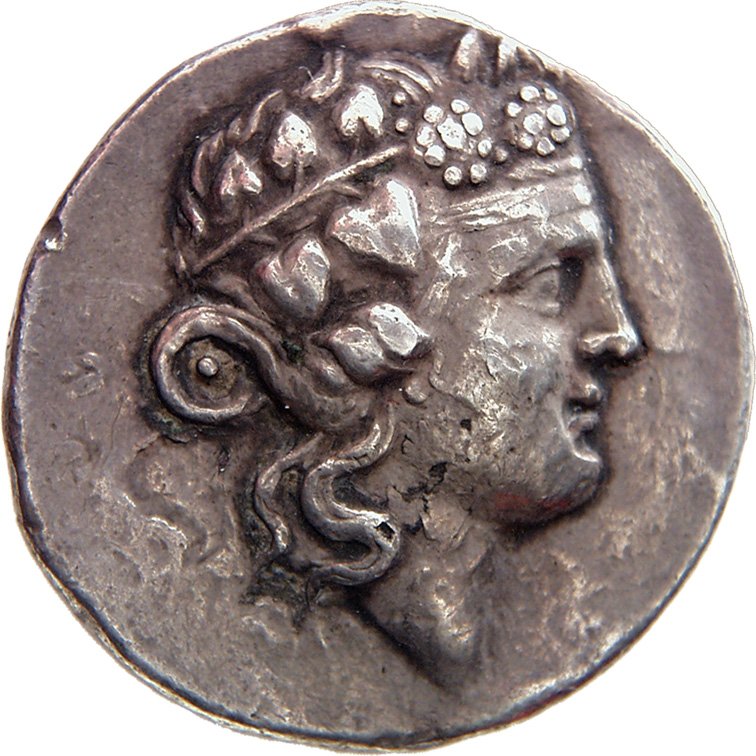
Thasian silver tetradrachm
Classical Antiquities
| Date | ca. 550–525 B.C. |
|---|---|
| Object type | vase |
| Medium, technique | hand-modelled, stamped, clay |
| Dimensions | height: 14.1 cm; diameter: 46.5 cm |
| Inventory number | 2000.25.A |
| Collection | Classical Antiquities |
| On view | This artwork is not on display |
The Etruscans inhabited the area in Italy north of Rome, bordered by the rivers Tiber and Arno. Their big urban centres that started to emerge in the second half of the 8th century B.C. and the surrounding territories constituted political units similar to the Greek city-states. They spoke the same language, and they also had institutions in common, nevertheless, the city-states themselves functioned independently; their culture, including their art forms had markedly individual features. Those settlements got prosperous and started to flourish soonest that were situated close to the mountains rich in ore. They acted as middlemen in the lively commerce with Greek and Phoenician merchants, and had their profit of the same. Fairly soon a seaside town in Southern Etruria sprang into prominence among them: it was Caere, the present-day Cerveteri. The town lay on a high flank of the Tolfa mountains, six kilometres from the sea and approximately forty kilometres from Rome to the northwest, and flourished between the 7th and the 4th centuries.
The local artisans were naturally interested in everything they could pick up in skill from the objects imported from across the sea – from Egypt, the Near East and Greece – but they also developed a number of new types that were unmistakably Etruscan, moreover, clearly Caeretan, and which, judging by the great number of the surviving pieces, must have been extremely popular among the local customers. One of these types is the product of a potter’s workshop, usually mentioned as ‘red ware’. The workshop that flourished for at least a hundred years starting from the last quarter of the 7th century, specialized in only two shapes of vessels produced with identical methods. One of them is a 70-90-centimetre tall, handleless storage vase (pithos in Greek), ovoid in shape, the other is the brazier, produced in series in 30 to 50 centimetres in diameter, The complete specimen kept in the Collection of Antiquities belongs among the latter group.
The vessels were made of roughly finished, grainy clay (impasto), thrown on a potter’s wheel, the thickness of their wall is approximately 1,5-2 centimetres. They were assembled of several parts, and the surface where these were joined was smoothed over before getting the pottery into the kiln. At the side of the Budapest piece it is clearly visible where the vessel and its base were joined, and also at the top, where the signs of finishing the ornate rim separately are easily discernible. Before firing, the vessels were coated with a smoother layer of clay, especially the surfaces that were visible: this coating gained a brownish red hue in the kiln. They were decorated mostly with a raised friese, which was stamped with a cylinder before firing. This ornamental technique had had its precedents in the great cultures of the Near East, whence the Greeks and Etruscans borrowed it, mainly in the 7th century. The carving of the stamps required special skills and a good deal of experience (since the negatives of tiny, millimetre-sized figures or motifs needed to be carved into the cylinder), so it clearly was the job for a special sort of craftsmen, and not the potters. In most cases they used various, hard, semiprecious stones for the carving of the stamps.
What might have caused difficulties was the inevitable conflict of the size of the vessel and the size of the impressed scene, which often forced craftsmen to resort to subsidiary solutions. In the two friezes of the Budapest brazier the scenes repeated were obviously made by the same cylinder: a stationary water-bird, two butting goats, and a man chasing a hare into a net with two raised sticks, and two dogs in front of him hot on the scent of the hare. The scene takes up approximately 21 centimetres and is repeated six times in both friezes. Still, the surface of the rim was somewhat bigger than that, so in the upper frieze the two dogs had to be complemented by a third one (next to the fissure, on the right), and in the lower, wider frieze, somewhat to the left, the artisan had to reimpress the left part of the scene starting with the net and ending with one of the sticks of the runner. Naturally, a stamp was used for embellishing several vessels: so far some five or six objects have come to light bearing the same imprint as the one we find in the frieze of the Budapest brazier.
The style of the decorative friezes is the surest way to date the vessels. The popular theme of hare-hunting appears in an almost identical form in the Etruscan vase painting of the middle of the 6th century, so the dating of the Budapest vessel can be traced back to the third quarter of the century.
Though the specimens of both types of vessels were mostly found in graves, originally their place was in the habitation area, the home. The broad-rimmed, thus portable brazier could be used for holding coal (judging by the burnmarks found in some specimens), cooking and heating, so its place must have been in habitation areas where the family gathered. It may have accompanied the dead to their tombs, but entombment was only their secondary function, as it has been made clear in the past few decades by the excavations of the residential area of Caere.
Following JÁNOS GYÖRGY SZILÁGYI
This record is subject to revision due to ongoing research.